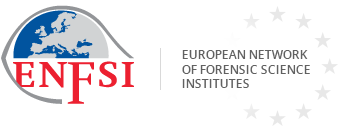2009: Cedric Neumann
Cedric Neumann has won the Emerging Forensic Scientist Award 2009.
Biography
Cedric (born in 1975) graduated from the University of Lausanne, Switzerland, with a BSc in Forensic Science in 1998. The main subject of his degree’s research project was, at the time, already concerned with ink evidence. Professor Pierre Margot approached him and offered him to pursue his work on the interpretation of ink evidence as part of a PhD thesis (which was completed in 2008).
The “Ecole des Science Criminelles” of the University of Lausanne has, over its past century of existence, built many strong relationships with prestigious forensic institutions. Cedric met Dr Tony Cantu, chief scientist of the United States Secret Service (USSS) – now retired, during one of his regular visit in Lausanne. Dr. Cantu is well known for his work in the field of ink analysis, ink dating, and for developing and supporting the International Ink Library, hosted by the USSS.
Following this meeting, Cedric was invited, in 2001, to work on the International Ink Library at the USSS headquarter in Washington, DC. It is during this time in Washington, working closely with Dr. Cantu and Robert Ramotowski (now chief scientist of the USSS), that Cedric laid the premises of what is now known as the Digital Ink Library of the USSS.
In 2004, building on his work on the interpretation of ink evidence, Cedric joined the Research and Development department of the Forensic Science Service (FSS) to contribute to a project aimed at developing a statistical framework for the assessment of weight of fingerprint evidence.
While working at the FSS and pursuing his PhD, Cedric was awarded in 2006 a grant from the Department of Homeland Security (DHS) of the United States of America. The purpose of the grant was to apply the results of his PhD research to the International Ink Library and (a) standardise the analysis of ink sampled by HPTLC, (b) automate the search and comparison of samples in large databases, and (c) develop a software package to manage electronically the ink library, its samples and the ink cases processed at the USSS (e-casefile).
This project was delivered by a team located in 5 different sites, in 3 different countries and combining the efforts of the University of Lausanne (Professor Christophe Champod, Thibault Genessay), CAMAG (Dr. Erik Reich, Roger James), the USSS (Robert Ramotowski, Gerry Laporte and Joseph Stephens) and DHS (Shane Cullen).
The Digital Ink Library was inaugurated on January 30th, 2009, by the Under-Secretary of DHS, in Washington. Cedric and Thibault were presented with a Certificate of Appreciation for their contribution to US law enforcement.
Cedric is currently still employed by the FSS and, since 2006, is in charge of the FSS’s R&D Statistics and Interpretation Research Group. Cedric is primarily working on a fingerprint statistical method for the evaluation of the weight of fingerprint evidence during the fingerprint examination process.
Cedric has updated the community on the progress of his work on ink and fingerprint at numerous occasions. Presentations on the ink project were notably made at the EAFS conferences in Lausanne (1997), Krakow (2000), Istanbul (2003) and Helsinki (2006). Presentations on the fingerprint project were made at the EAFS conferences in Helsinki and Glasgow (2009), at the ENFSI fingerprint working group, as well as in the United States. Results of these research projects were also published in Forensic Science International, Journal of Forensic Science and the Journal of Forensic Identification.
Key publications
- C. Neumann, P. Margot (2009), New perspectives in the use of ink evidence in forensic science – Part I: development of a quality assurance process for forensic ink analysis by HPTLC, Forensic Sci Int, Vol 185, pp 29–37.
- C. Neumann, P. Margot (2009), New perspectives in the use of ink evidence in forensic science – Part II: development and testing of mathematical algorithms for the automatic comparison of ink samples analysed by HPTLC, Forensic Sci Int, Vol 185, pp 38–50.
- C. Neumann (2009), Interpretation of ink evidence in forensic science , In: A.Jamieson, A. Moensens(Eds.), Encyclopedia of ForensicSciences 2nd Edition, Wiley&Sons, Chichester.
- C. Neumann, P. Margot (2009), New perspectives in the use of ink evidence in forensic science – Part III: Operational applications and evaluation.,Forensic Sci Int, Vol 192, pp 29-42.
- C. Neumann, P. Margot (2009), Considerations on the ASTM Standards 1789-04 and 1422-05 on the forensic examination of ink. J For Science, In Press.
- C. Neumann (2008), New perspectives in the use of ink evidence in forensic science, PhD Thesis, University of Lausanne, 163 p.
- P. Gill, J. Curran, C. Neumann, A. Kirkham, T. Clayton, J. Whitaker, J. Lambert, (2008) Interpretation of complex DNA profiles using empirical models and a method to measure their robustness, Forensic Sci. Int: Genetics, Vol. 2(2), pp 91-103.
- P. Gill, J Curran, C Neumann (2008), Interpretation of complex DNA profiles using Tippett plots, Forensic Sci Int: Genetics Supplement Series, 1(1), pp. 646-648
- A. Anthonioz, N. Egli, C. Champod, C. Neumann, R. Puch-Solis, A. Bromage-Griffiths (2008), Level 3 details and their role in fingerprint identification: A survey among practitioners, Journal of Forensic Identification, Vol 58(5), pp 562-589.
- C. Neumann, C. Champod, R. Puch-Solis, N. Egli, A. Anthonioz, A. Bromage-Griffiths, (2007) Computation of likelihood ratios in fingerprint identification for configurations of any number of minutiæ, J. of Forensic Sci, Vol 52(1), pp. 54-64.
- C. Neumann, C. Champod, R. Puch-Solis, N. Egli, A. Anthonioz, D. Meuwly, (2006) Computation of likelihood ratios in fingerprint identification for configurations of three minutiæ, J. of Forensic Sci, Vol 51(6), pp. 1255-1266
- C. Neumann, W.D. Mazzella, (2004) Questioned Document. In: Encyclopaedia of Analytical Science, Academic Press, pp. 465-471.
